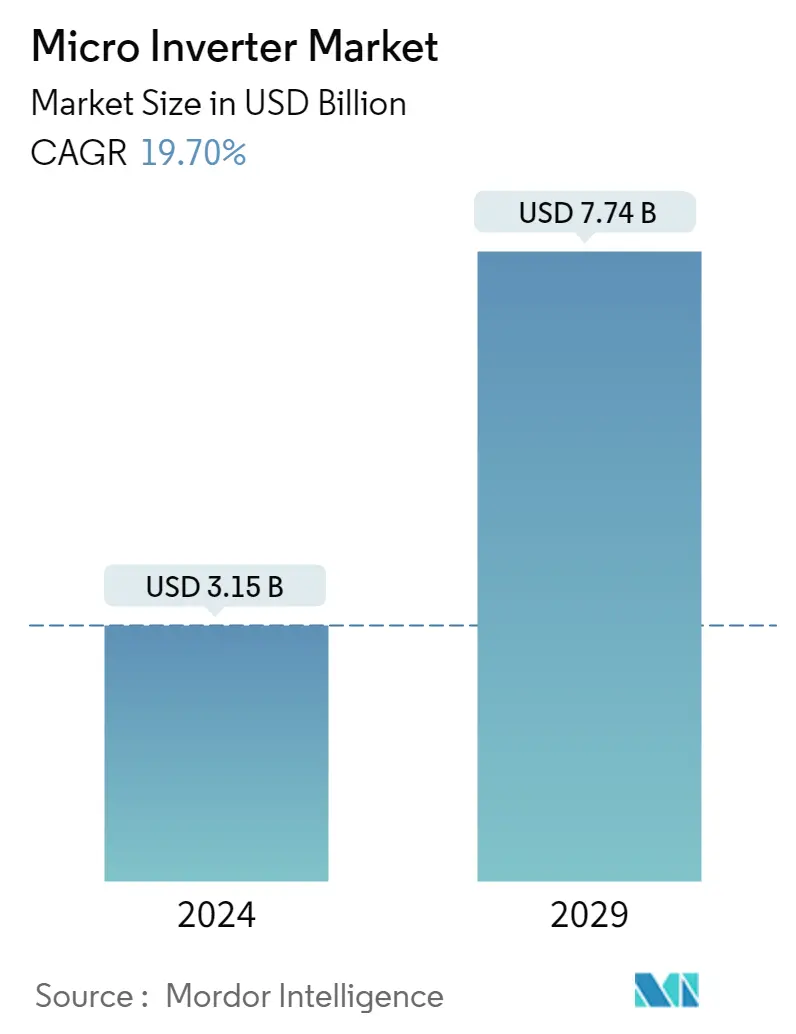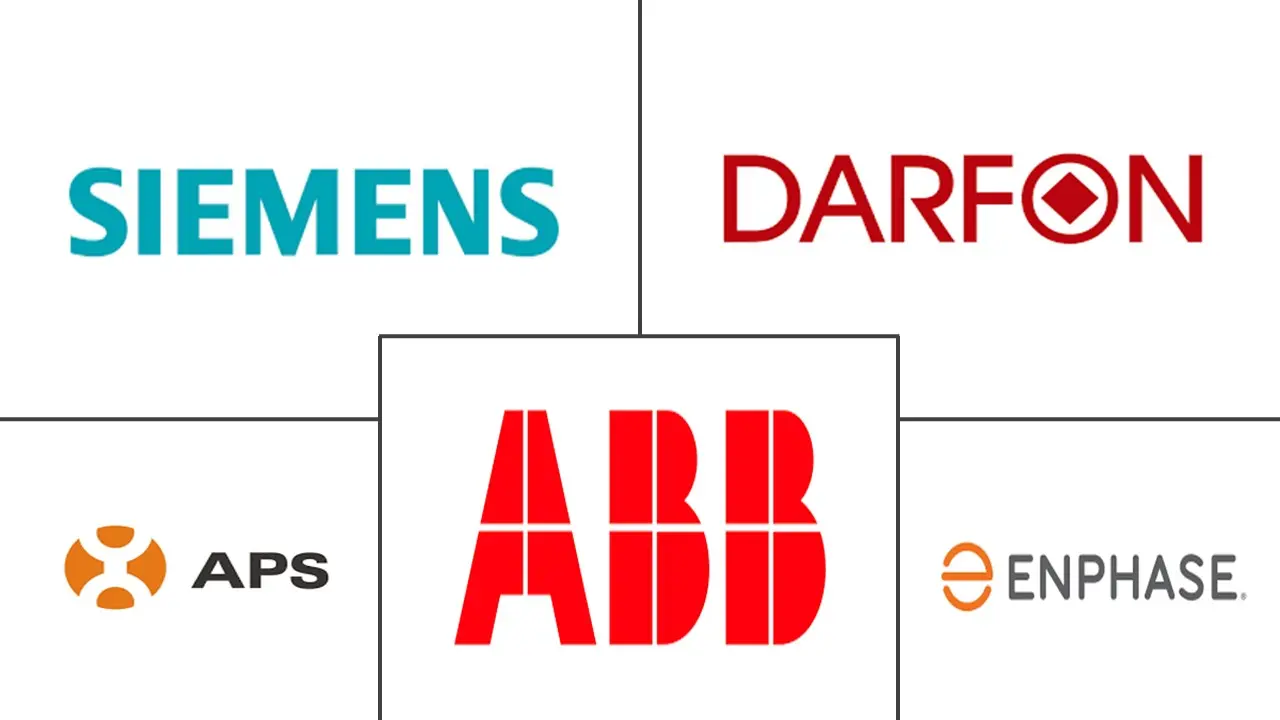Market Size of Micro Inverter Industry

| Study Period | 2019 - 2029 |
| Market Size (2024) | USD 3.15 Billion |
| Market Size (2029) | USD 7.74 Billion |
| CAGR (2024 - 2029) | 19.70 % |
| Fastest Growing Market | Asia-Pacific |
| Largest Market | North America |
Major Players
*Disclaimer: Major Players sorted in no particular order |
Micro Inverter Market Analysis
The Micro Inverter Market size is estimated at USD 3.15 billion in 2024, and is expected to reach USD 7.74 billion by 2029, growing at a CAGR of 19.70% during the forecast period (2024-2029).
The factors like enabling module-level monitoring, easier installation, enhanced design flexibility, removing the need for DC switching points, and better safety than conventional inverters are some factors that are fueling the growth of the micro inverter market.
- Constant R&D activities and significant reductions in the costs of microinverters drive the micro inverter market. Furthermore, the market also receives a considerable boost due to its compact size and versatility. Additionally, the increasing requirement of consumers, based on modularity, safety, and maximum energy harvest, will continue to drive the market at a considerable pace in the forecast period.
- The demand for micro inverters has enabled companies to develop increased battery storage. In April 2022, energy storage provider Yotta Energy, Austin, Texas, announced that it had been awarded a USD 1.97 million contract to install a solar + storage microgrid at Nellis Air Force Base in Las Vegas.
- Due to the varying use of micro inverters, they are widely adopted worldwide. They provide various benefits such as design flexibility and capabilities like producing the maximum power from solar panels through maximum power point tracking (MPPT) technology. These factors have helped the micro-inverter market gain an advantage over other inverters in residential and commercial applications.
- The demand for micro inverters has enabled companies to develop increased battery storage. In April 2022, Yotta Energy of Austin, Texas, was awarded a USD 1.97 million contract to install a solar + storage microgrid at Nellis Air Force Base in Las Vegas. The company believes batteries are headed in the same direction: module-level microstorage. The business is deploying a 52lb, 1kWh lithium-iron-phosphate battery on the same solar module racking gear, which holds the ballast.
- Worldwide renewable electricity capacity is predicted to expand by more than 60% from 2020 to over 4,800 (GW) by 2026, equaling the total global power capacity of fossil fuels and nuclear power combined, according to the International Energy Agency (an intergovernmental agency).
Micro Inverter Industry Segmentation
A micro inverter is a plug-and-play device used in photovoltaics that converts the direct current generated by a single solar module to alternating current. The micro inverter is segmented based on type (single phase and three phases), communication technology (wired and wireless), sales channel (direct and indirect), application (residential, commercial, and PV power plant), geography (North America, Europe, Asia-Pacific, and Rest of the world). The market sizes and forecasts are provided in terms of value (USD million) for all the above segments.
| By Type | |
| Single Phase | |
| Three Phase |
| By Communication Technology | |
| Wired | |
| Wireless |
| By Sales Channel | |
| Direct | |
| Indirect |
| By Application | |
| Residential | |
| Commercial | |
| PV Power Plant |
| Geography | |
| North America | |
| Europe | |
| Asia-Pacific | |
| Rest of the World |
Micro Inverter Market Size Summary
The micro inverter market is poised for significant growth, driven by factors such as module-level monitoring, easier installation, and enhanced design flexibility. These inverters offer better safety compared to conventional options, making them increasingly popular in residential and commercial applications. The market benefits from ongoing research and development, cost reductions, and the compact, versatile nature of micro inverters. The demand for these devices is further bolstered by the need for modularity, safety, and maximum energy harvest, which are crucial for solar photovoltaic systems. The adoption of micro inverters is expanding globally, with notable developments such as Yotta Energy's solar + storage microgrid installation at Nellis Air Force Base, highlighting the technology's growing importance in energy storage solutions.
The micro inverter market is expected to experience robust growth, particularly in the Asia-Pacific region, where countries like China, Japan, India, and Australia are enhancing their solar PV installation capacities. The increasing adoption of solar photovoltaics in residential sectors, driven by cost savings and climate change mitigation efforts, is a key factor propelling market expansion. Government policies, financial incentives, and decreasing solar PV costs are also contributing to the market's growth. The market is characterized by a high level of fragmentation, with major players such as Enphase Energy Inc., Altenergy Power System Inc., and ABB Ltd. actively engaging in strategies like product launches and partnerships to strengthen their market presence.
Micro Inverter Market Size - Table of Contents
-
1. MARKET DYNAMICS
-
1.1 Market Overview
-
1.2 Market Drivers
-
1.2.1 Rise in benefits and awareness about the renewable energy sources along with increased adoption
-
1.2.2 Cost-effectiveness and increased developments of these products
-
-
1.3 Market Restraints
-
1.3.1 High installation and maintenance costs
-
-
1.4 Industry Value Chain Analysis
-
1.5 Industry Attractiveness - Porter's Five Forces Analysis
-
1.5.1 Threat of New Entrants
-
1.5.2 Bargaining Power of Buyers
-
1.5.3 Bargaining Power of Suppliers
-
1.5.4 Threat of Substitute Products
-
1.5.5 Intensity of Competitive Rivalry
-
-
1.6 Assessment of Impact of Covid-19 on the Micro Inverter Market
-
-
2. MARKET SEGMENTATION
-
2.1 By Type
-
2.1.1 Single Phase
-
2.1.2 Three Phase
-
-
2.2 By Communication Technology
-
2.2.1 Wired
-
2.2.2 Wireless
-
-
2.3 By Sales Channel
-
2.3.1 Direct
-
2.3.2 Indirect
-
-
2.4 By Application
-
2.4.1 Residential
-
2.4.2 Commercial
-
2.4.3 PV Power Plant
-
-
2.5 Geography
-
2.5.1 North America
-
2.5.2 Europe
-
2.5.3 Asia-Pacific
-
2.5.4 Rest of the World
-
-
Micro Inverter Market Size FAQs
How big is the Micro Inverter Market?
The Micro Inverter Market size is expected to reach USD 3.15 billion in 2024 and grow at a CAGR of 19.70% to reach USD 7.74 billion by 2029.
What is the current Micro Inverter Market size?
In 2024, the Micro Inverter Market size is expected to reach USD 3.15 billion.

